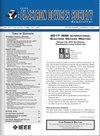HfO₂ Thin Films by Chemical Beam Vapor Deposition for Large Resistive Switching Memristors
IF 2
3区 工程技术
Q3 ENGINEERING, ELECTRICAL & ELECTRONIC
引用次数: 0
Abstract
We present chemical beam vapor deposition (CBVD) as a valuable technique for the fabrication of good quality HfO2-based memristors. This deposition technique gives the opportunity to rapidly screen material properties in combinatorial mode and to reproduce the optimized conditions homogenously on large substrates. Cu/HfO2/Pt memory devices with three different oxide thicknesses were fabricated and electrically characterized. A bipolar resistive switching and forming free behavior was seen in all the tested devices. Lower switching voltages than similar devices fabricated by employing different deposition techniques were observed. The conduction mechanism in the low resistance state can be ascribed to filamentary copper, while a trap-controlled space charge limited current conduction was observed in the high resistance state. The comparative evaluation of devices with different oxide thicknesses allows to infer that devices with thicker HfO2 film (25 nm) are more performing in terms of ROFF/RON ratio (利用化学气束气相沉积技术制备用于大电阻开关晶闸管的 HfO₂ 薄膜
我们介绍的化学束气相沉积(CBVD)技术是制造优质二氧化铪忆阻器的重要技术。这种沉积技术能以组合模式快速筛选材料特性,并在大型基底上均匀复制优化条件。我们制作了具有三种不同氧化物厚度的铜/HfO2/铂存储器件,并对其进行了电学表征。所有测试器件都具有双极电阻开关和无形成行为。与采用不同沉积技术制造的类似器件相比,该器件的开关电压更低。低电阻状态下的传导机制可归因于丝状铜,而在高电阻状态下则观察到受陷阱控制的空间电荷限制的电流传导。通过对具有不同氧化物厚度的器件进行比较评估,可以推断出具有较厚 HfO2 薄膜(25 nm)的器件在 ROFF/RON 比(10{^{{6}}$)方面性能更佳,而且在低电阻和高电阻状态下都能在 100 多个周期内重复电阻开关。更薄的氧化物器件(20 nm 和 16 nm)尽管具有类似的长保持时间(10{^{{4}}$ )和更低的 SET/RESET 电压,但却显示出更小的内存窗口和开关不稳定性。这些结果与文献中报道的采用其他沉积技术实现的类似存储器结构的结果相比,表明 CBVD 是实现基于 HfO2 的高性能非易失性存储器件的一种有前途的技术。
本文章由计算机程序翻译,如有差异,请以英文原文为准。
求助全文
约1分钟内获得全文
求助全文
来源期刊

IEEE Journal of the Electron Devices Society
Biochemistry, Genetics and Molecular Biology-Biotechnology
CiteScore
5.20
自引率
4.30%
发文量
124
审稿时长
9 weeks
期刊介绍:
The IEEE Journal of the Electron Devices Society (J-EDS) is an open-access, fully electronic scientific journal publishing papers ranging from fundamental to applied research that are scientifically rigorous and relevant to electron devices. The J-EDS publishes original and significant contributions relating to the theory, modelling, design, performance, and reliability of electron and ion integrated circuit devices and interconnects, involving insulators, metals, organic materials, micro-plasmas, semiconductors, quantum-effect structures, vacuum devices, and emerging materials with applications in bioelectronics, biomedical electronics, computation, communications, displays, microelectromechanics, imaging, micro-actuators, nanodevices, optoelectronics, photovoltaics, power IC''s, and micro-sensors. Tutorial and review papers on these subjects are, also, published. And, occasionally special issues with a collection of papers on particular areas in more depth and breadth are, also, published. J-EDS publishes all papers that are judged to be technically valid and original.
 求助内容:
求助内容: 应助结果提醒方式:
应助结果提醒方式:


